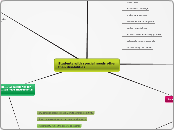Students with special needs other than disabilities
I dont fit into the IDEA categories
Autism, Deaf, Deaf-Blind, Dev. Delay, Emotional Dist., Hearing Impared, Intellectual Dis., Multiple Dis., Orthopedic, Other Health Imp.. Specific Learning Dis., Speech/Lang., Traumatic Brain Injury, Visual Imp.,
I do not fall in the IDEA categories for disabilities, But I still need Instructional Focus
INCLUDE:
indentify
note needs
check for areas of success
look for problems
use information to brainstrom
DIFFERNTIATE INSTRUCTION
Evaluate
Section 504
any condition that substantially limits a major life activity
does not provide funds to carry out requirements
responsibility fall on the general ed teacher
Regulations are similar to IDEA
must be screened using RTI
MDT
determine eligibility for service
create a plan
Accomodations
Individualized
level the playing field for learning
Examples
seat student nearest to where teacher leads most instruction
provide clues indicating beginning and ending times for instruction or assignments
establish home/school communication
fold assignments in half to keep from being overwhelmed
make directions, expectations and repremands consise and clear
free from distracting items
pace instruction with more variety and change over
practice tests
multiple sets of text books to ease burden of remembering
occasional rest periods
opportunities to take medication
exemption from certain physical activity
provisions to make up work
frequent bathroom breaks
permission to postpone highstakes tests when blood glucose is low
record lessons so learner can hear them again
testing in separate, quiet location
test is read aloud
access to T2S software
Visual organizers
high levels of participation
draw on interests
work with peers
Curriculum compacting
acceleration and enrichment
differentiated instruction
individualized interventions
more choiceregarding assignments
offering ways other than reading to aquire information
arrange for peer tutoring in struggling area
student-centered learning
small group peer interactions
segmenting and blending
association between written and sounds
build reading fluency
teach vocab
enhance oral language
multicultural education
bilingual education programs
set high expectations
establish peers as teaching partners
collaborate with professionals
support family involvement
Who gets the 504?
Chronic Health or Medical problems
ex: asthma, severe allergies, diabetes
Students with Learning Problems
significant learning problems, but no determined to have a learning disability according to state criteria
Example: Dyslexia
Affects school success
ADHD
inattentive
carless mistakes
easily distracted
seems not to listen
lacks detail
fails to finish tasks
difficulty organizing
avoids tasks that require sustained attention
loses things
forgetful
hyperactive
fidgety
unable to stay seated
restless/climbing
difficulty keeping friends
talking excessively
prone to temper tantrums
bossy
defiant
impulsivity
blurt out answers
difficulty awaiting turn
interrupting
acting before thinking
viewed as immature
failing to read directions
Gifted
1988 Jacob Javits Gifted and Talented Students Education Act
Federal legislation does not require specific services- determined by state and city
6%
Academics and talent
problems
un-nurtured talent
can be unpopular or well liked
show off
sensitive to others feelings
behavior issues
model students or problem child
Culturally Diverse Students
often lack role models
differnet teaching approches needed
RTI
cultural values differ
At Risk
poverty
abuse
live with drug abusers
Subtopic
As a teacher I should:
UBD
multisensory presentation
mutiple means of action and expression
multiple means of engagement
More about ADHD
inability to regulate attention
Working memory
ability to remember what tasks are to be done and how much time to do it
self-directed speech
silent self-talk that manages complex tasks
Control of emotions and motivation
ability to calm oneself
Reconstitution
ability to transfer skills
Common Characteristics
Inat
Risks
Social Emotional
conflicts with parents and teachers
disruptive
to classmates
outbursts
problems with authority
depression
low self esteem
difficulty making fiends
problem areas
math
fast computation
Medication and other cautions
do not blame parents
do not condone inappropriate behavior
Meds
Concerta
Ritalin
Focalin
Dexedrine
Adderall
Tofranil and Norpramin
Catapress
Straterra
